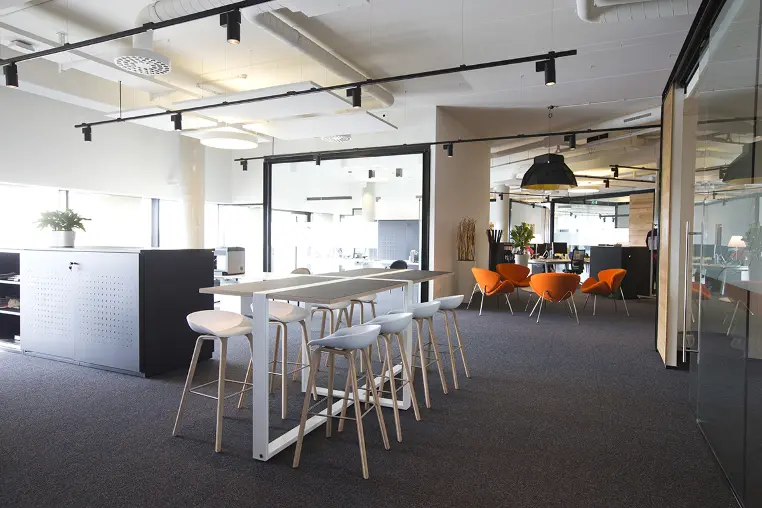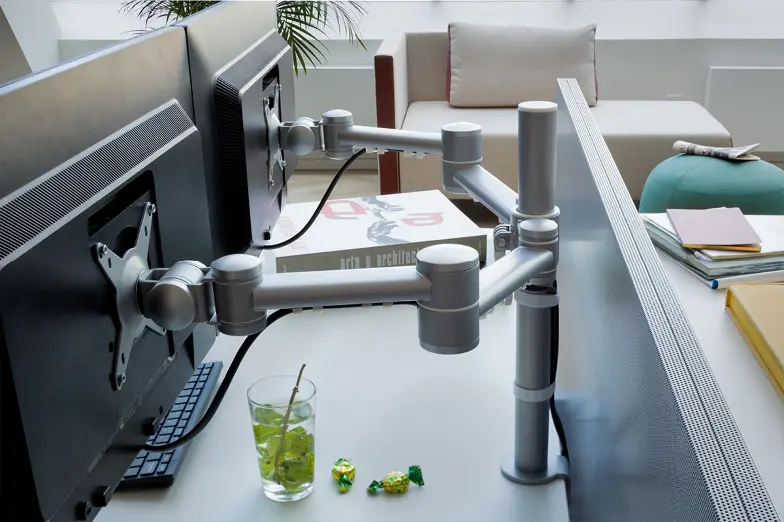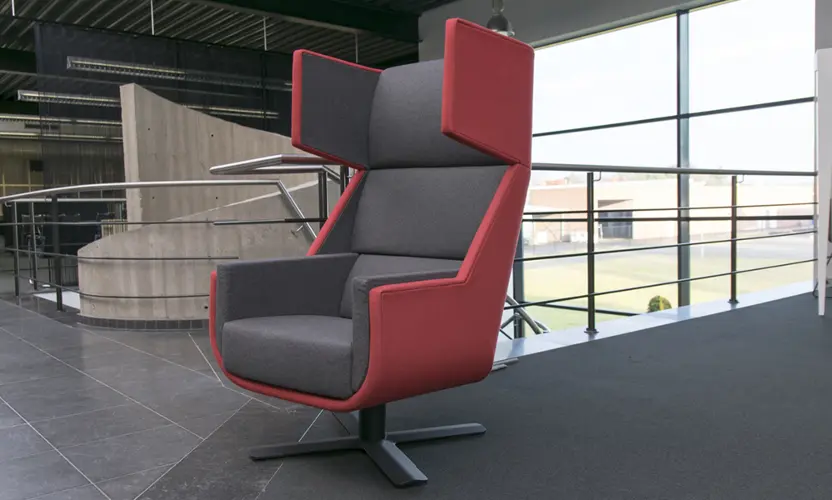DKV Belgium

Accessible healthcare.
No paper, no cables and maximum mobility: a gradual revolution at DKV
Reducing the surface area while improving the well-being of employees; achievable. Combining the relocation of the company with a thorough revision of their processes; daring. Add to that the development of entrepreneurship and the core business towards service provision and customer contact, and you're facing an impressive list of challenges! Nevertheless, insurer DKV managed to do it all quickly and without any crises.
Back in 2015, sister companies DKV, the ultimate reference for health insurance for individuals, and ERGO, specialised in retirement savings, life insurance and investments, were operating from a 12,160 m2 office at Madouplein in Brussels. As the end of their lease was approaching, they asked themselves the classic question: to stay or to leave? “We were operating from a typical blockhaus from the seventies with small windows, low ceilings, yellow walls and linoleum floors”, said Emmanuel de Talhouët who had just been appointed CEO. “I joined a magnificent company, but one that isn’t quite aware of the digital revolution and the inflation of healthcare. Good results and a solid reputation were getting in the way of the company's internal development ability. Their way of working, with lots of paper-based processes, was outdated. Many aspects of their approach had to change: putting the customer first again, more teamwork, modernising their processes, etc. In addition, the building at Madouplein no longer met the basic needs of our employees: functional mobility, with reorganised teams, reducing paper flows to benefit telephone contact, expanding the activities, launching new products and the associated marketing efforts, and with a need for larger rooms for collaboration to boot.”
Reinvesting in a location that supports mobility
The goal of the project was to reduce the surface area and associated costs as well as to implement remote work and the NWOW. They needed a location that would promote mobility because DKV had only one branch in Belgium and their staff came from all over the country: “We considered building”, said Emmanuel de Talhouët. “But there would not be enough time from the end of our lease to being granted a permit. The needs had to be analysed, specifically the ratio between FTEs and the number of workstations, which remained a big question mark. What percentage would be working from home? How large would the new building ideally be? We needed six to eight months to draft the specifications. The opportunity arose to move into a building that was yet to be constructed in Noordwijk, a perfect place for the desired mobility. However, it wasn’t very safe at night; unacceptable for our largely female workforce.”
At the same moment in time, the ‘Central Plaza’ building was vacant and the expected new tenant had withdrawn. DKV jumped on the opportunity. “With the help of a consultancy firm, we analysed the needs and issued a structured tender”, said Emmanuel de Talhouët. “We signed a preliminary commitment subject to a successful fit-out. We drafted a detailed site plan and called on Colliers to manage the project from start to finish as a delegated principal.”
Complete change of operation
Switching to paperless, digitising everything, creating a digital archive and making the tools available to their departments, optimising certain workflows to stop receiving hardcopy documents for manual signature, modernising their support services (finance, HR, marketing) which were still completely reliant on paper... all preparatory measures were taken in anticipation of the move and executed upon their arrival at Central Plaza.
“We hired a company to guide us through these changes”, said Emmanual de Talhouët. “Colliers was responsible for the ‘bricks’ aspect, another partner for ‘behaviour’ and ‘bytes’ were managed internally. How did the staff respond? “The response was two-fold: on the one hand, our employees were very enthusiastic about reorganising the company but they also had questions about how it would all come about. We managed to answer those questions and our employees set out to change our instruments and methodologies: we switched from a core business focused on document processing to one that focuses on serving our clients. Of course, we still end up doing the same thing: issuing refunds. But the approach is different now. It helped our staff leave behind the safety of their paper bunker and venture out to discover something new; customer contact. This also means more telephone calls and feedback that isn’t necessarily pleasant to hear: when something goes wrong, we have to be able to find the right arguments. But we also get a lot of highly positive feedback that our employees enjoy very much.
The switch to a paperless working method was more difficult for certain support departments such as marketing, where people are concerned with reputation management and where the ability to visualise print is paramount. But since we were asking our clients to go digital as well, failure on our side was not an option.”
“Suddenly talking about it becomes pointless and you just have to go and do it”
“We decided to test the concept with two volunteering departments”, witnessed the current CIO (Chief Integration Officer for the integration of the two entities of DKV and ERGO). “They were told to stop using paper altogether for three months. Meanwhile, we implemented two teleworking days for everyone including myself as their boss and we relaxed our punch clock rules. It all contributed to the quality of life which was greatly appreciated. Those who made use of it were able to sell the benefits to the others. The test also showed that our initial fears had been unfounded.”
So, everything went smoothly then? “Not at all! It was extremely challenging!”, admitted Emmanuel de Talhouët. “Bringing a project like that home requires complete trust when you depart from a situation where the organisation does not yet know the NWOW. You must be prepared to take risks and even gamble at times. For example, we assumed that 70 workstations for every 100 employees would suffice. I received the following response: No can do, the accounting department will not have enough space.” The same goes for the paperless and wireless way of working: “It can’t be done with a mainframe! It’s a constant battle against the spontaneous tendency to fall back on the trusted situation. Switching to something new is to take risks. Which is why it is so important to comfort the teams. The details of execution are the main challenge in any project: lots of small things will not work. But when you set out to change how you work on top of that, you run into one problem after another. This was truly a triple project: facility, HR - with a year of intense guidance and training - and IT.”
Source: Profacility.be











